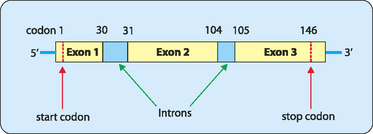chapter 20 DNA, RNA and protein synthesis
 The flow of information from DNA through mRNA to protein is known as the central dogma of molecular biology.
The flow of information from DNA through mRNA to protein is known as the central dogma of molecular biology. A gene is a portion of DNA, identified by a sequence of nucleotides, which provides information for the synthesis of not only protein but also of tRNA and rRNA.
A gene is a portion of DNA, identified by a sequence of nucleotides, which provides information for the synthesis of not only protein but also of tRNA and rRNA. Ribosomal RNA (rRNA) is associated with protein making up the ribosome, the site for protein synthesis.
Ribosomal RNA (rRNA) is associated with protein making up the ribosome, the site for protein synthesis. Translation is the interpretation of the codes in mRNA into an amino acid sequence of the protein to be synthesised.
Translation is the interpretation of the codes in mRNA into an amino acid sequence of the protein to be synthesised.Earlier chapters have shown how the cell can use a number of different proteins to create all of its components. Some of these proteins are enzymes and catalyse the formation of other parts of the cell such as lipids. Others are structural proteins that provide a scaffold within the cell. The properties of all of these proteins are determined by the sequence of amino acids within the protein. How then does a cell ‘know’ what that sequence of amino acids should be?
The information that instructs the cell on how to make each and every one of its proteins is encoded in the DNA contained in the cell. As outlined in Chapter 9, DNA is made up of many molecules of the four different nucleotides A, G, C and T joined together as a large polymeric molecule. The information contained in DNA is determined by the sequence of the different nucleotides that arises when moving along the DNA strand.
Genes
The information stored in the DNA of chromosomes is divided up into discrete, heritable units or genes. Each gene has a particular role in the cell. The majority of genes provide the instructions or code for making proteins, as shown in Figure 20-1.
Some genes do not encode for protein, rather provide the instructions of specialised RNA molecules such as tRNA and rRNA (Fig 20-2), which play an active role in protein synthesis.
Chromosomes
When humans reproduce specialised sex cells, or gametes, are made; sperm in males and ova in females. When these cells are made the pairs of chromosomes are split up such that each member of each pair ends up in different cells. When fertilisation occurs the chromosomes from one sperm and one ovum are mixed together to give the full complement of 46 chromosomes in the developing fetus.
Characteristics of a mammalian gene
Within the DNA of a chromosome are small stretches of DNA or motifs that identify a gene. These include a promoter region, which contains motifs that indicate the beginning of a gene. This defines the place at which the cell should start copying the DNA into mRNA. Yet other motifs instruct the cell where to stop copying the DNA. The message in the gene is not continuous, as shown in Figure 20-3.
Stay updated, free articles. Join our Telegram channel

Full access? Get Clinical Tree













